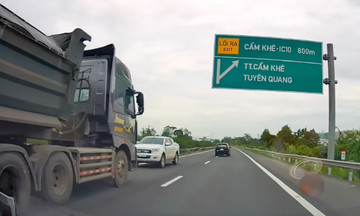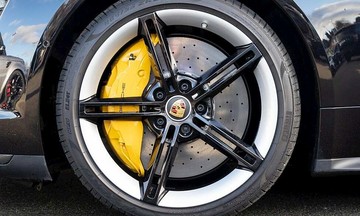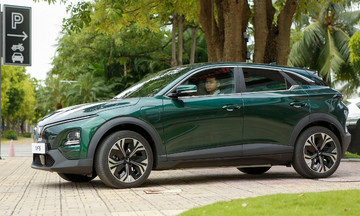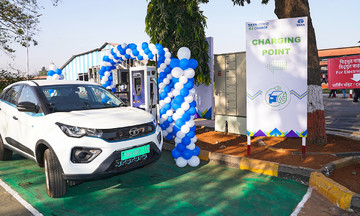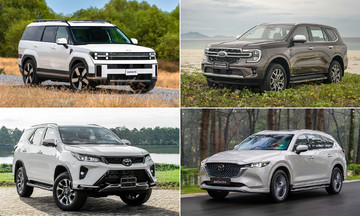Competition in Vietnam's mid-size SUV segment primarily revolves around the three best-selling models: the Hyundai Santa Fe, the Toyota Fortuner, and the Ford Everest. The Toyota, representing traditional values and brand strength, once led Vietnamese consumer trends. However, the landscape shifted with the 2018 arrival of the 4th-generation Santa Fe.
With its fresh interior and exterior design and numerous user-friendly features, the locally assembled Santa Fe gradually became the dominant choice from 2018 onwards. But by 2023, the Everest emerged as the most popular option.
Santa Fe sales reached over 10,000 units in 2022, then dropped to 6,941 in 2024, a decrease of approximately 35%. During the same period, Everest sales climbed from 6,979 to 10,841, a 55% increase.
According to data from the Vietnam Automobile Manufacturers' Association (VAMA) and Hyundai Thanh Cong, the entire mid-size CUV/SUV segment saw 34,078 vehicle sales in 2022. By 2024, sales decreased by 23% to 26,041 units. Thus, while overall segment sales and direct competitors declined, the Ford model bucked the trend.
2022 marked a significant shift in Ford's product strategy, both globally and in Vietnam. The new designs of the Ranger and Everest, both built on the same platform, embraced a more muscular, American style and distinct personality. This was accompanied by a focus on maximizing comfort, making a body-on-frame vehicle feel more like a unibody car in terms of user experience and safety features.
These new features in the third generation, along with maintaining a wide range of diesel engine options, helped the Everest gradually overtake the Santa Fe from 2023. The Toyota Fortuner also remained among the top three best-selling models in the segment, but the gap with its American and Korean rivals widened considerably. With its unchanged design and engine for many years, the Toyota model seemingly fell behind.
As the Everest's sales surged thanks to its new generation, the Santa Fe entered 2023 and 2024 nearing the end of its life cycle. Frequent substantial discounts offered by Ford and its dealerships further expanded the Everest's influence.
In 2024, the Everest achieved record sales since its 2005 debut in Vietnam. That year, the Ford model captured about 42% of the segment's market share, doubling its 20% share in 2022. Meanwhile, the Santa Fe's share fell from 31% to 27%. The Fortuner experienced the steepest decline among the three, from 22% to 13%.
The Santa Fe had a chance to turn the tables in 9/2024, but the launch of its fifth generation didn't generate the expected sales boost. Still locally assembled and priced similarly to the Everest, with increased comfort and safety features, the Korean model faced mixed reactions to its design (mainly the rear) and the elimination of the diesel option.
 |
Santa Fe and Everest in Vietnam. Photo: HTC, FVN |
Santa Fe and Everest in Vietnam. Photo: HTC, FVN
Industry experts suggest that the absence of a diesel version is one reason for the Santa Fe's declining appeal, although this is a global Hyundai strategy, not specific to the Vietnamese market. Conversely, main competitors like the Fortuner maintain both diesel and gasoline versions. The Everest has even sought to expand its diesel engine options within its product lineup.
"Whether a design is good or bad is subjective, but by losing the diesel version, the Santa Fe also lost a significant number of customers," commented Nguyen Vu, former sales director of an authorized Korean car dealership and current operator of a used car company in Dong Nai.
According to Mr. Vu, the diesel version consistently accounted for the majority of Santa Fe sales during the generation sold from 2018. Mid-size SUV buyers are not typically affluent and are more sensitive to operating costs compared to those in the E-segment or luxury segments. With the larger size and weight of mid-size SUVs, the diesel version is often preferred for fuel efficiency. Customers outside of major cities like Hanoi or Ho Chi Minh City, who frequently travel through hilly and mountainous terrain, are even more inclined towards diesel engines.
This preference for diesel engines has led many manufacturers to prioritize offering this option. In 2020, the Mitsubishi Pajero Sport's mid-cycle update eliminated the gasoline version. The new-generation Everest, initially launched in 2022 with four diesel variants, now offers six, the most in the segment.
Many customers appreciate that Hyundai and its subsidiary Kia's diesel engine technology offers the smooth operation of a gasoline engine while providing better fuel economy. Currently, used previous-generation Santa Fe models equipped with diesel engines are priced similarly, or even slightly higher, than the newer versions.
In the first half of 2025, Santa Fe sales showed no signs of recovery. Cumulative sales up to May reached only 918 units, lower than even the Fortuner's 1,111 units and far behind the Everest's leading 4,012 units. Hyundai's market share in the segment has dwindled to 12%, while the Ford model commands 52%.
Pham Trung



